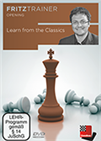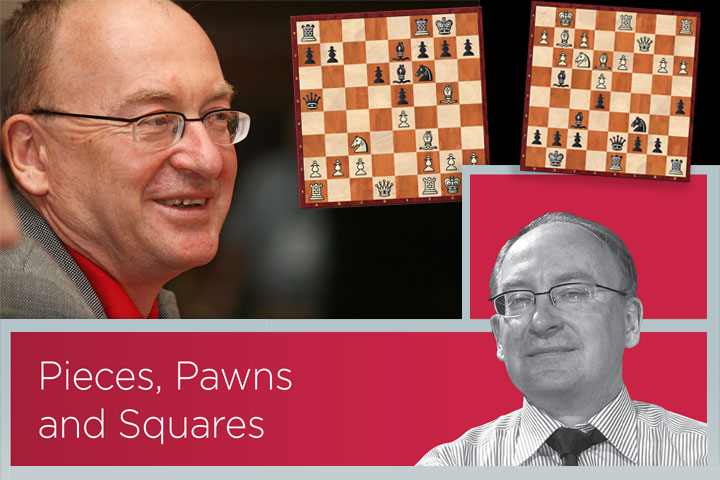A review
Adrian Mikhalchishin says this new video series is about "technique" and begins to give his own definition of what technique consists in. But in reality, the videos begin by showing what is a "weakness" — how we can create weaknesses in the enemy camp and how we can exploit them.
 Mikhalchishin's explanations are definitely an eye-opener because now every time I'll try to learn an opening, I'll think in terms of weaknesses — the targets in our opponent's position that we can exploit. This also gives us a forma mentis, which means when we study or play a certain opening we know which squares are bad for our opponents. The good thing in chess is the huge amount of top material available. We can watch many games on a particular opening, map the good or bad squares, learn from those before us how they exploited those weaknesses and won games and avoid reinventing the wheel.
Mikhalchishin's explanations are definitely an eye-opener because now every time I'll try to learn an opening, I'll think in terms of weaknesses — the targets in our opponent's position that we can exploit. This also gives us a forma mentis, which means when we study or play a certain opening we know which squares are bad for our opponents. The good thing in chess is the huge amount of top material available. We can watch many games on a particular opening, map the good or bad squares, learn from those before us how they exploited those weaknesses and won games and avoid reinventing the wheel.
The grandmaster begins the video series swiftly! Yes, you understood me well, generally, authors dedicate one video to the introduction of the material. Instead, Mikhalchishin after a little more than a minute, begins to delve into the instruction.
After watching one of Mikhalchishin's videos, rich like a velvet chocolate cheesecake, I copy and paste the game into one of my own personal databases, and while watching the game on the chessboard, I try to reproduce the comments he made. In this way, I see what I remember, what I don't, and what is not clear.
Here an example of a game I worked on. For those interested in deepening the knowledge of how to fight against the Sicilian Defence, Mikhalchishin recently released a DVD focusing only on how Bobby Fischer played against it.
Fischer liked to play aggressive but basically sound lines against the Sicilian and many of his variations are still very much alive and a good choice for players of all levels.
While one must strive to understand the games used as examples, Mikhalchishin goes one step further showing how he put into practice what he learned from Botvinnik in his own games. I'm not giving all the annotations as Mikhalchishin does, because that can be found within the DVD, I'm just interested noting how great his teaching method is!
 On this DVD GM Adrian Mikhalchishin presents games of the World Champions of the past to explain typical patterns and strategic concepts of these games and to show how grandmasters apply these ideas today.
On this DVD GM Adrian Mikhalchishin presents games of the World Champions of the past to explain typical patterns and strategic concepts of these games and to show how grandmasters apply these ideas today. Mikhalchishin shares some wisdom which is important for reaching the next stage. For example, when showing one game between Judit Polgar and Anand, he says: "In some positions, it is better not to exchange pieces..." this is important, because often when we gain a material advantage, we try to exchange all the pieces. Such a mistake could easily lead us to draw. Instead, keeping the pieces on the board may be the way to a win, depending on the specifics. Again, in order to know when and when not to exchange the pieces one must follow Mikhalchishin's videos and pay attention to the details of which positions tend to work, and which don't.
The lessons from Mikhalchishin also come in the form of sayings from greats of the past, like Bronstein:

What's in the video series?
The videos are based on 71 games, and then there is a database of further examples with 57 games. The first five videos are on how to create weaknesses. Mikhalchishin also explains the concept of double weakness. Often to create only one weakness is not enough for winning a game against a strong player. Hence the use of technique to create a second weakness, which will become decisive in determining the result of the game.
The full explanation of the term "technique" is much more rich in Mikhalchishin's explanations than I can do justice in a review. For example, just in the first game, Mikhalchishin explained a lot of concepts, corrected the mistakes made by the players, showing how they should have played, and then showed a slew of vital technical manoeuvres. This is extremely important because when I'll watch other games by myself, I'll be able to connect new material back to what Mikhalchishin was saying, reinforcing my chess knowledge.
I'd like to show one of the amazing manoeuvres explained by Mikhalchishin:

White wants to enter on c8, but if she does it with the queen, the queens are exchanged, allowing the Black king to go to d7, keeping the file under control. In this case, one needs to find a manoeuvre which can invert the queen and rook so that the latter can lead the invasion. This is what Mikhalchishin demonstrates as the key concept!
Now I could have surely replayed that game from the Informant or another source, but thanks to Mikhalchishin I've learned the importance of that manoeuvre, and understood the game at a level I would have not reached by myself.
Some games end in beautiful combinations. Try the following one against the engine, Black just played 55...exf4; find how White wins the game:
There are ten videos on the topic of conquering important squares and how to transfer the pieces from one side of the board to the other.
 Sagar Shah shows you on this DVD how you can use typical patterns used by the Master of the past in your own games. From opening play to middlegame themes.
Sagar Shah shows you on this DVD how you can use typical patterns used by the Master of the past in your own games. From opening play to middlegame themes. As the title suggests, there are also eight videos dedicated to pawns. While in previous DVDs Mikhalchishin taught about pawn structures in relation to middlegame plans, now we learn to use the pawns in specific moments of the game. More specifically we learn how to limit the mobility of some pawns. But in general, the theme is the attainment of specific goals, such as creating maximum damage with the use of a single pawn. One piece of advice (which is also common to other ChessBase authors is to study the classics) because in them we find important examples of the different uses of pawns, like those explained by Mikhalchishin. As is often the case, the synthesis of certain teachings is made by a World Champion, in this case, the key figure to understand classics (like Alekhine, Capablanca, Lasker) is Botvinnik, who had to deeply understand the games of his predecessors, in order to achieve an even higher level of chess understanding.
The video series ends with 17 videos of test positions, where we can discover which parts we understood, and which need to be reinforced. I'd like to reiterate the point about the databases which come with this series: Many don't think a DVD or video series is in any way like a book, but Mikhalchishin's selection of "further examples" containing 57 games, plus the primary set of 71 games on which all videos are based is really like studying a chess book with over 120 games. Way more bang for your buck!
Pros and cons
First, on a sartorial note, I like the way Mikhalchishin dresses. He is always professional shirt and tie, like a professor. He conveys this aura of expertise in the field, which makes chess professional too! Clearly a great ambassador for the game.
Mikhalchishin goes very fast, maybe to some this is a no-no, for me, it is the sign he tries to give all his wisdom he has, as fast as he can, without wasting a second. Which means the DVD is packed with information, which can take months or years to digest!
Now we are always told to study chess books. For example many maneuvers, pawn ideas etc. can be found in classic books like Nimzowitsch's Chess Praxis. However, I find spending time with this DVD more productive, because in just 18 minutes — the time of one video — I can learn many ideas explained in Chess Praxis, using a modern language, and with a pragmatic approach.
Here's an example position:
Mikhalchishin begins by explaining the anomalies in the opening, like the strange position of the Be3, and then shows the move 9.h4! a common recurrent move in modern games. But the way Mikhalchishin explains it makes more sense to me and gave me ideas which I will use in my own games. Practically we are taught how to create maximum damage in the enemy territory with just one pawn!
Final thoughts
Mikhalchishin provides databases of selected games which are very important for our development as chess players. Those databases are made to impress on our chess minds example after example of how to convert an advantage into a won game. Backed by considerable teaching experience. Mikhalchishin gives us the patterns which we must know. In just 30 minutes a day, one can finish Mikhalchishin's DVD within a few weeks, and apply the knowledge gained in one's own tournament games. Don't lose this chance to be trained by one of the best chess coaches of all time!
Treated themes: how to create weaknesses, how to conquer and exploit important squares, the powerful helping pawn, piece transfer to strongholds, coordination in the attack.
Links


















 Mikhalchishin's explanations are definitely an eye-opener because now every time I'll try to learn an opening, I'll think in terms of weaknesses — the targets in our opponent's position that we can exploit. This also gives us a forma mentis, which means when we study or play a certain opening we know which squares are bad for our opponents. The good thing in chess is the huge amount of top material available. We can watch many games on a particular opening, map the good or bad squares, learn from those before us how they exploited those weaknesses and won games and avoid reinventing the wheel.
Mikhalchishin's explanations are definitely an eye-opener because now every time I'll try to learn an opening, I'll think in terms of weaknesses — the targets in our opponent's position that we can exploit. This also gives us a forma mentis, which means when we study or play a certain opening we know which squares are bad for our opponents. The good thing in chess is the huge amount of top material available. We can watch many games on a particular opening, map the good or bad squares, learn from those before us how they exploited those weaknesses and won games and avoid reinventing the wheel.





